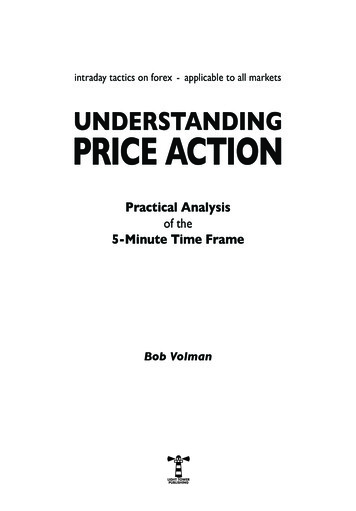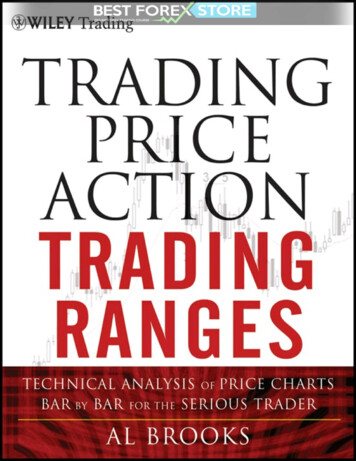
Transcription
intraday tactics on forex - applicable to all marketsUNDERSTANDINGPRICE ACTIONPractical Analysisof the5-Minute Time FrameBob Volman
Copyright 2014 by Bob Volman. All rights reserved.Published by: Light Tower PublishingISBN 978-90-822786-0-6ProRealTime charts used with permission of www.ProRealTime.comNo part of this publication may be reproduced, distributed, or transmitted in anyform or by any means, including photocopying, recording, or other electronic ormechanical methods, without the prior written permission of the author, exceptin the case of brief quotations embodied in critical reviews and certain othernoncommercial uses permitted by copyright law. For permission requests, writeto the author at the address below.upabook@gmail.comExcerpts of the book can be downloaded from:www.upabook.wordpress.comDisclaimer: This publication is solely designed for the purposes of informationand education. Neither the publisher nor author shall be liable for any loss,claims or damage incurred by any person as a consequence of the use of, or reliance on, the contents herein.
Table of ContentsPreface VPart 1: Practical AnalysisChapter 1:A Time to Trade and a Time to StudyChapter 2:Price Action Principles—Theory 3 5Double pressure 6Support and resistance 8False breaks, tease breaks and proper breaks 11False highs and lows 16Pullbacks reversals 20Ceiling test 25Round number effect 30Chapter 3:Price Action Principles—PracticeChapter 4:Orders, Target and StopChapter 5:Trade Setups 33 67 73Pattern break 76Pattern break pullback 97Pattern break combi 108Pullback reversal 125Chapter 6:Manual Exits 143News report exit 144Resistance exit 148Reversal exit 156Chapter 7:Skipping Trades and Trading Breaks for FailureChapter 8:Recap Part 1 177 211
Part 2: Evaluation and ManagementChapter 9:Consecutive Intraday Charts 245March 250April 272May 293June 316July 337August 359Chapter 10:Trade Size—CompoundingChapter 11:Adapting to Low VolatilityChapter 12:Final Words 391 421About the AuthorIndex 383 422 423
PrefaceIn these modern times of high-tech trading devices, with all the latestgadgets at the push of a button, price action traders may come off assomewhat old-school. With nothing in front of them but the bars in thechart, there is little in their workspace that bears witness of the digitalwave. Are they mere relics from a fading past, soon to be extinct, orcould it be that there is merit in this seemingly stubborn defiance oftrading evolution?One way to answer this is to point out the actual benefits of everyindicator craze that has swept across the trading landscape for thepast so many years. Not an easy chore by any means. A simpler solu tion, perhaps, is to focus attention on the price action trader insteadand see if we can come to appreciate his one and only tool, the nakedchart.With the latter idea in mind, Understanding Price Action is writtennot just to establish the virtues of the price action method, but to serveas a practical guide on the matter. The core premise within is that anydedicated student, before long, should be able to trade confidentlyand profitably from a clean chart without ever feeling lost or otherwise deprived.For the purpose of illustration, any price chart could basically do,but few are better suited for the job than the 5-minute chart of the eur/usd currency pair. A true creature of habit, this market has long sincebeen the favorite of countless traders around the globe and it’s hard to5
Understanding Price Action Excerptsthink of a more accessible platform for the technical discussions in thechapters ahead.When taking up the task of writing this guide, the objective was notjust to show a pallet of trading concepts on a number of cherry-pickedcharts, but to give a fair impression also of their practical implementation on a day-to-day basis. For this purpose, the book has been splitinto two parts.Part 1 lays out the principles of price action and discusses entry andexit techniques on a broad range of educational charts. In Part 2 we willexamine how these findings hold up on a more continuous basis. Included within is a series of six months of consecutive 5-minute sessionsof the eur/usd. Besides providing a massive amount of study material,this series should leave little doubt behind as to the amazing continuityand exploitability of price action themes from one session to the next.One of the most common questions I received in response to myfirst book, Forex Price Action Scalping, was if the principles and setupspointed out on a fast scalping chart (70-tick) could also be applied to thehigher intraday frames, like the 2 or 5-minute, or even the hourly forthat matter. There can only be one answer to this question: price actionprinciples are transposable to any time frame of choice because theybear within them the universal laws of supply and demand. This is notbounded by the time in which it takes place, nor is it a prerogative ofany one market. From one instrument or time frame to another, subtleadaptations may be called for, if only to accommodate for the differences in average range or motion; but the trading concepts of the priceaction method are just as applicable to futures, indices, stocks, commodities, bonds, or what have you, as they are to the Forex markets.As will be demonstrated also, price action principles are not onlyfree from the boundaries of market and frame, they stand above thenature of the trading environment as well. To illustrate this point, aspecial section is included on how to tackle a very persistent climate oflow volatility by slightly tweaking standard procedure to better suit theconditions at hand. We will examine this adaptation process from theviewpoint of a faster intraday frame on several currency pairs and somepopular non-Forex markets.6
Understanding Price Action ExcerptsIn regard to the absolute novice, it should be noted that to keep thefocus at all times directed towards analysis, it is chosen not to disturbthe pace of this book with endless pages of introductory fluff that isreadily available either online or in more generic trading books. From atechnical perspective, however, Understanding Price Action is written forboth the novice and the experienced trader, and for all who have takeninterest in exploring the benefits and possibilities of the price actionmethod.7
Understanding Price Action ExcerptsExcerpts from Chapter 3:Price Action Principles—PracticeFigure 3.1 This chart serves well to illustrate the concept of the doublepressure pop stemming from a buildup situation (bull swings 3-4, 7-8and 13-14). Without delving into details of entry and exit technique,let’s find out if there were price action principles at work that may havehinted at the coming of these powerful breakouts.A little before the European Open at 08:00, bulls had slowly takenthe initiative (prices above the 25ema), but their dominance was farfrom outspoken. To their credit, they had managed to successfully fendoff a bear attack in bar 1, which had put a mini higher low in the chart.A little bullish cue.With prices back on the 25ema, a small pattern line may alreadyhave been plotted as depicted, but it wasn’t a telling boundary by anymeans. The line did earn merit, though, when bar 2 briefly broke out onthe upside, only to retreat and close below it. A point won by the bears.Note: When plotting lines for visual assistance, there is no need tolook for anything grand. Small boundaries (spanning about an hour ofprice action) can be very effective also. For bullish purposes, draw yourlines either flat, or let them slope down across some descending highs,never up; vice versa for breaks on the bear side. But do keep in mindthat any pattern line, big or small, is always a function of personal interpretation. If only for this reason, the mere perforation of a line may8
Understanding Price Action Excerptsnot make for the best of trading signals. The break of a 5-minute bar,on the other hand, is incontestable and the more crucial the position ofthis bar in relation to the neighboring price action, the bigger the impactof its break. This principle lies at the base of our operating tactics andthe general idea will be to trade the break of such a bar more or less inconjunction with a pattern line perforation. On occasion, we may already enter before our pattern line itself is taken out, but more commonis to hop along shortly after the event.The first breakout situation is a good example of the latter. Note howbar 3 opened more or less on the pattern line (low of the white body),then went down a bit, only to close bullishly outside the pattern (highof the white body). This was a token of bullish resilience, but no crucialbar was broken yet. The very moment the high of bar 3 was taken out,however, bulls didn’t waste time buying themselves in, leaving plentyof bears little choice but to quickly buy out. A classic double-pressuresituation. (From what is shown on the left of this chart, it’s hard to saywhether this truly called for action.)While there are countless ways to snap up prices in a pullback (4-6),the conservative route is to wait for the correction to hit upon a technicalelement in the chart (a test of support or resistance), and then see ifprices can find some footing in it (buildup). If you take position merely onaccount of an attractive retracement level, say, a 50 percent correctionof the foregoing swing, you are basically resorting to tactics of the hopeand-pray variety. Buying or selling straight into a technical test is notwithout danger either, for prices may very well march through it, if onlyto shake out the parties who came in with a tight stop. Hence the recommended approach of waiting for some bars to settle in the area first.The 1-3 cluster from where the first bull swing had taken off is agood example of an area of technical support. On balance, the thickersuch a block on the left, the harder it will be for prices to fully cutthrough it on their way down.Quite like an angular line can help to mark a boundary of interest,wrapping a box around a cluster of neighboring bars can be very usefulalso, particularly when dealing with a potential reversal in the high orlow of a pullback. A single horizontal line at the side of the anticipated9
Understanding Price Action Excerptsbreak may suffice, but a box can really help to visualize the tension inthe turn (5-6-7).Underneath the dotted pullback line, bar 7 was a false low with itsdirect neighbor and a higher low inside the box. When this bar wastaken out topside, so too was the resistance of the box pattern, thepullback line, the 25ema and the round number. Such a confluence ofbroken sweetspots present in a single breakout stands to work to thebenefit of follow-through simply because it will have many traders focustheir attention on the very same break; and contrarians are less likelyto counter such event.It took some pushing and pulling in the current highs of the market(double top 8-9), but once bar 9 was broken down, bulls finally let goand a bearish pullback ensued (9-10). Note that this correction onlyretraced about 50 percent of the foregoing swing 7-8, an indication thatthe bulls were keen on keeping the pressure up.While conservatism in the markets is highly promoted, it is alwaysa pleasant fact that many parties have no problem with aggression.For example, the typical buying of the proverbial falling knife
and see if we can come to appreciate his one and only tool, the naked chart. With the latter idea in mind, Understanding Price Action is written not just to establish the virtues of the price action method, but to serve as a practical guide on the matter. The core premise within is that any dedicated student, before long, should be able to trade confidently and profitably from a clean chart .











